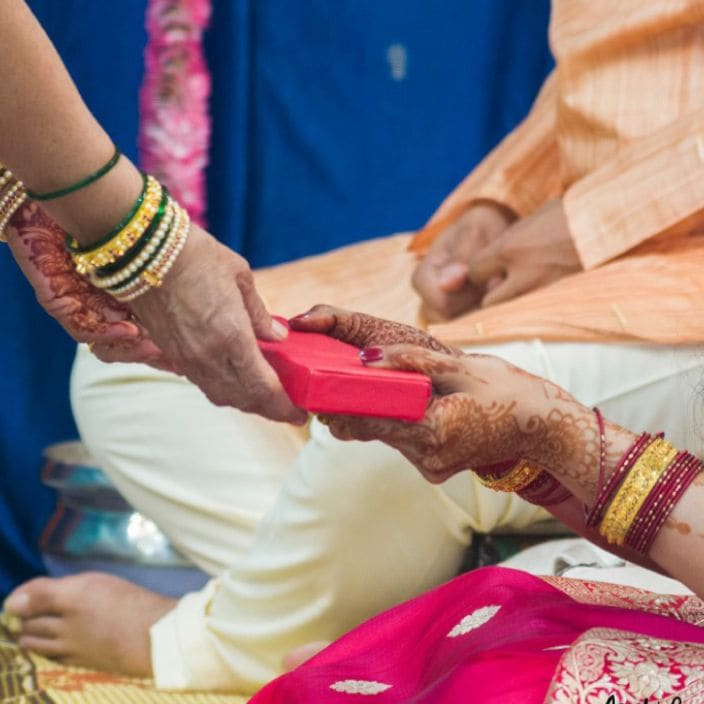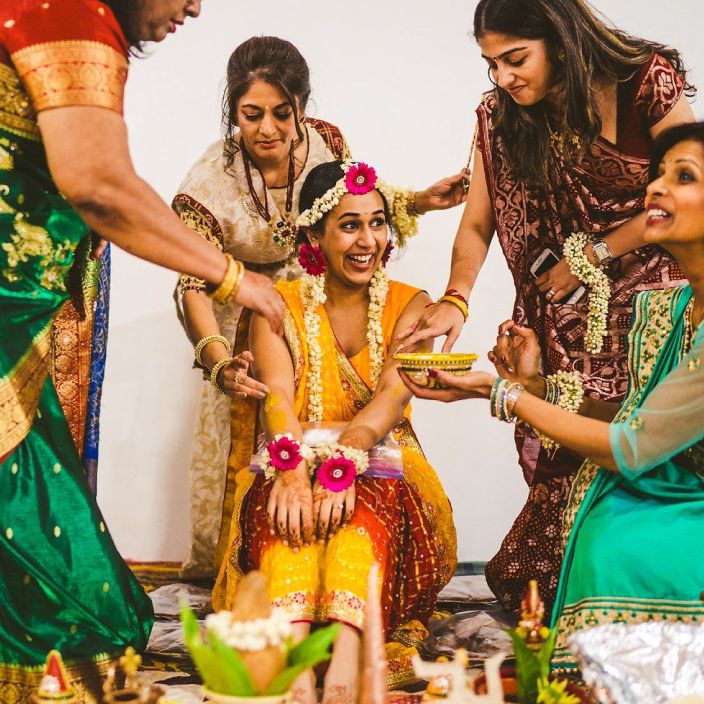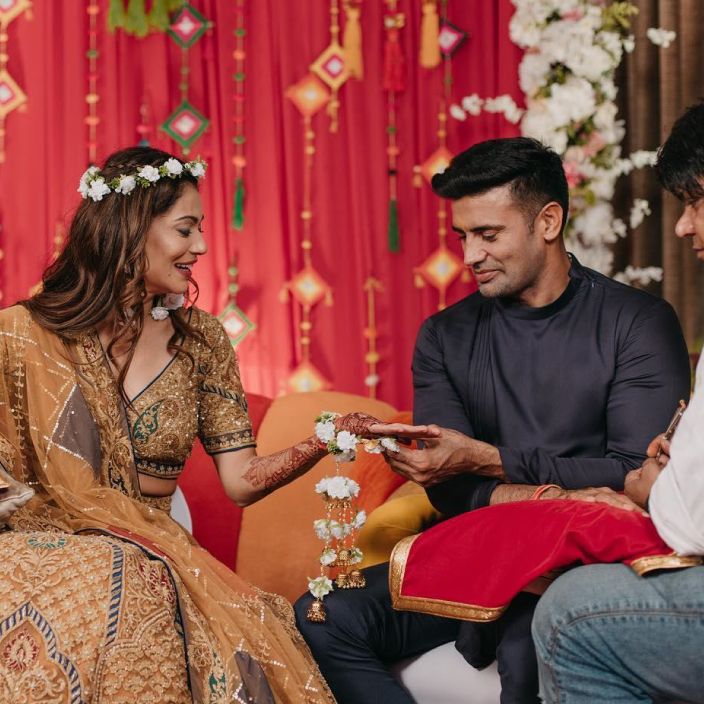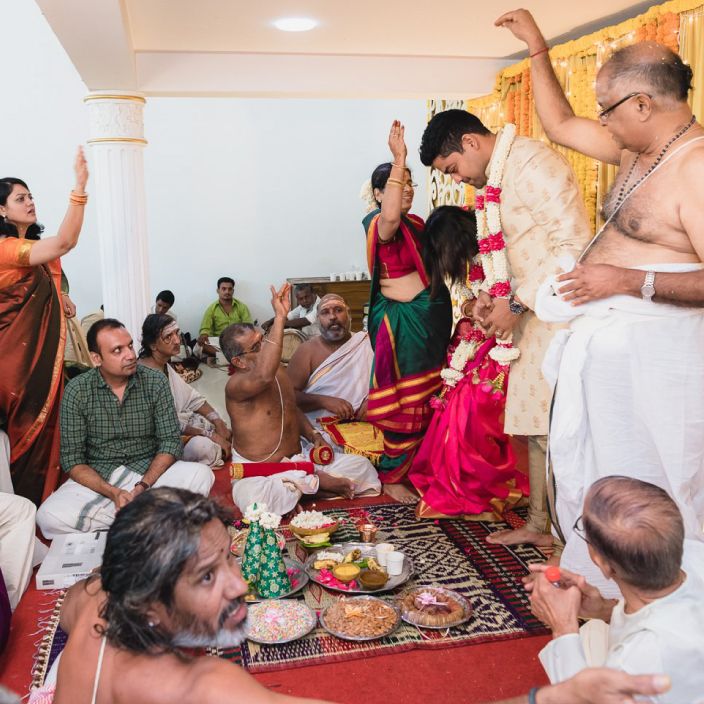For best prices and early deliveries, WhatsApp us at. 918488070070
Himachal Pradesh
Known for its breathtaking scenery, Himachal Pradesh is a beautiful state located in the foothills of the Himalayas. It is home to Hindu communities and several tribal communities. The mix of these cultures seeps into their food, fashion, lifestyle, and weddings. Most of the Hindu weddings follow Vedic customs, similar to other North Indian ceremonies, combined with local traditions.
Tracing the Traditions
The first event in a Himachal Pradesh wedding is the Roka ceremony. Similar to an engagement ceremony, the bride and groom come together with their families in an intimate arrangement. They exchange rings as a promise of marriage, after which they officially share the news of their wedding with the larger community.
After the Roka, preparations begin in full force with a series of pre-wedding rituals that go on until the wedding. One of the most anticipated events is the ‘Halad’ or Haldi ceremony. At this event, the bride and groom invite family and close friends to their home or host the event at a venue. The guests apply a paste of turmeric and sandalwood on the couple’s arms and face.
A pre-wedding ceremony unique to Himachal Pradesh is the Mama Swagat. Mama means ‘uncle’, and swagat means ‘to welcome’. In this sweet tradition, the bride’s maternal uncle and family are hosted at the groom’s house, accompanied by music, food, and sweets, to welcome him to their family. Another special ceremony is the Sehra Bandi — here, sehra refers to a classic turban that is tied by hand. In this ritual, the groom’s uncle ties the groom’s turban as a symbol of love and respect. Another significant pre-wedding tradition is the Tika Ceremony, during which the bride’s family officially welcomes the groom by applying a ceremonial tika on his forehead.
After all the pre-wedding rituals are completed, it is time for the big wedding function. As per tradition, the bride’s family receives the groom and his family at the venue. The bride’s mother performs an aarti, puts vermillion or tilak on the groom, and escorts him to the wedding stage. Here, a mandap is set up, which includes a ceremonial fire around which the priest conducts the rites.
The bride makes her grand entrance, escorted by her parents and uncles. After this, the couple exchanges flower garlands in the Jaimala ceremony, and the father officially gives his daughter to the groom in the Kanyadaan ceremony. During the Saptapadi ritual, a red dupatta is tied between the bride and groom to symbolise their bond. Together, they take seven rounds or saat pheras around the holy fire. Each round represents a sacred vow of love and commitment between them. After this, they are formally married in the presence of God and their loved ones. Once the couple is formally married, the wedding celebrations continue with a Dhamu, a lavish feast that reflects the rich culinary heritage of Himachal Pradesh.
The newlyweds leave the wedding venue in the Vidaai ritual. The bride bids farewell to her family in an emotional goodbye. As a symbolic act, she throws rice and coins behind her to express gratitude toward her parents and leaves with her husband to start their new life. Among the post-wedding rituals is the Roovary ceremony, where the bride’s maternal uncle presents her with symbolic jewelry, such as bangles, as a token of blessings and love.
Wedding Attire
The attire worn at weddings reflects the state's rich textile heritage and skilled craftsmanship.
For the bride, the customary attire consists of long dresses that cover her from neck to toe usually worn with loose bottoms such as salwar or long skirts. These outfits, known as Ghagris and Cholis feature local embroidery and vibrant designs. The classic Salwar Kameez combination, paired with a flowing dupatta draped over the head, is also quite popular. On occasions like weddings and festivals, women adorn themselves with handwoven fabrics adorned with exquisite embroidery.
Jewellery plays a vital role in completing the bridal ensemble. The bride typically wears a Chakker, a silver headpiece that rests on her forehead, along with a round Chiri pendant that resembles a maangtikka and lies elegantly on her hair parting. Her ears are adorned with jhumkas – bell-shaped earrings with little bells. Around her neck, she wears a chanderhar necklace featuring layers of silver or gold beaded chains.
The bride also wears an assortment of colourful bangles along with traditional bracelets featuring intricate and elegant metalwork designs. To complete her ensemble, she wears a Pahaad – an anklet representing her bond with the mountains and a Nath – a classic nose ring for the ultimate bridal allure.
The groom typically adorns a Kurta paired with either a Dhoti or Churidar Pyjama. He pairs it with a silk gown, often crafted from yak leather and embellished with threads and embroidery to elevate his look. The groom's ensemble is complemented by a coloured turban, which symbolises pride and honour.
However, the groom’s look may differ across communities. Rajput men are recognised for their long moustaches and vibrant turbans, and they wear intricate outfits that celebrate their cultural roots. Brahmin men, however, prefer an understated turban style and a lengthy overcoat or waistcoat that reflects their adherence to tradition.
Traditional Cuisine
Traditional arches crafted from bamboo and decorated with flowers and leaves greet the guests at weddings. Torans made of flowers, mango leaves, and decorative beads are also hung at the entrance and throughout the venue. The seating area is often shaded by canopies or tents, creating a festive and cosy atmosphere for the guests.
Himachal Pradesh is renowned for its handloom textiles, which play a prominent role in wedding decorations. Traditional Kullu shawls, Chamba rumals (embroidered handkerchiefs), and colourful blankets are used as draperies, table covers, and decorative accents. Local pottery and earthenware are also popular for decor.
Traditional clay pots painted with elaborate designs function as flower vases or candle holders. Earthen lamps, known as diyas are strategically placed around the venue to create a warm ambience. Elaborately carved frames, panels, and sculptures adorn the mandap and other sections of the venue, adding sophistication to the event. The state is also known for its craftsmanship in brass and copper, which are often used to create decorative items such as vessels, bells, and statues. Flowers, like marigolds, roses, and seasonal blooms, also add a natural charm to wedding setups. Intricate floral rangolis are often crafted around the mandap and entrance areas.
Cultural Decor
At weddings, guests savour various dishes that showcase the region's culinary traditions. Chana Madra, known for its perfectly cooked chickpeas and rich curry, remains a popular choice. The traditional feast known as Dham is a standout, featuring a spread of rice, Rajma (kidney beans), Sepu Vadi (lentil dumplings in spinach gravy), and Mah Ki Dal (yellow lentils). Tudkiya Bhath, a rice dish cooked with lentils, vegetables, and spices, is typically served with mashed dal and a spoonful of ghee. Non-vegetarian attendees can relish the Kullu Trout — fresh trout marinated with spices and cooked to perfection. Patande or wheat flour pancakes are also relished on these occasions.
The dessert selection at Himachal Pradesh weddings is truly impressive. Mittha stands out as a sweet treat made with sweetened rice mixed with raisins and dry fruits; the addition of cardamom and saffron gives it its rich aroma.
You'll also find treats like Babroo, a fried bread filled with a sweet mix of jaggery and sesame seeds, often drizzled with honey or sugar syrup. Aktori, a dessert from Spiti, resembles a pancake made of buckwheat flour and served with powdered sugar or honey. Kheer is another must-have at the wedding; it is a rice pudding flavoured with cardamom and saffron topped with nuts.
The beverages at these weddings perfectly complement the spread. Chhang is an alcoholic brew crafted from fermented barley or millet enjoyed by both locals and guests. Lassi is another drink made from yoghurt, served either sweet or salty and infused with cardamom or rose water for that extra zing. And, of course, there's tea (Chai), an essential beverage served alongside snacks and desserts to provide warmth and cosiness up in the mountains.



